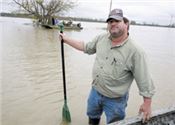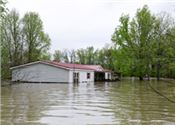|
South Delta Farmers Wait For Flood Waters To Recede

Waye Windham wades outside of his boat in Issaquena County, Mississippi, floodwaters
April 5, 2019.
Photo by MSU Extension Service/Michaela Parker
VALLEY PARK, MISS.
Near a bridge that connects Issaquena and Sharkey counties, Waye Windham leaned toward the side of his boat and dipped a paddle down into flood water to gauge its depth.
The water was too deep for the paddle to reach the ground. Riding with Windham was Lacey Little, who tried a much longer wooden post.
“That’s blacktop,” he said after he felt a thud. The boat was floating several feet above Mississippi Highway 1.
Most of the land between Mississippi Highway 465 and U.S. Highway 61 in the south Mississippi Delta is supposed to be cropland, but it’s a lake right now, full of backwater from the Yazoo River.
In February, storms dumped so much water in the Delta that rising Mississippi River levels forced the U.S. Army Corps of Engineers to close the Steele Bayou Control Structure. These gates are opened when the Mississippi River is lower than the 630,000-acre Yazoo Backwater area. They are closed to keep water from backing in from the Mississippi River when its elevation is too high.
The 145-foot-wide gates were reopened April 1, but the overflow will take several weeks to drain back into the river. According to the Corps, the area reached its highest elevation in 40 years last month.
Storms dumped 13 inches of rain in a short period north of the gates in Greenville. National Weather Service climatology data notes that February was the second wettest on record there.
“All this water has to go through 145 feet,” said Windham, who is one of 42 Issaquena County farmers affected by the floods. “Some of this water was in north Mississippi several weeks ago, and now it’s down here.”
The Mississippi State University Extension Service has personnel trained to provide relief in the immediate aftermath of flooding and to conduct damage assessment when the waters eventually subside.
“Extension personnel helped coordinate volunteers and food for a week for displaced residents,” said Emily Carter, MSU Extension agent in Issaquena and Sharkey counties. “We also had people filling and placing sandbags in the Valley Park area.”
Damage in Issaquena County was not limited to farms. Highway 1 is one of 20 roads closed there. Sixty-seven residents were displaced, according to the county’s emergency management agency, with water invading homes and enveloping vehicles and farm equipment.
“All of this backwater is about at its peak,” Carter said. “The gates are open, but a lot of melted snow from up north hasn’t yet made it here. If this water doesn’t exit fast enough, we could see a second round of flooding.”
Phillip Vandevere, MSU Extension coordinator in Yazoo County, said there were four waterlogged dwellings at peak flooding. Fifty-seven other homes were altered, meaning the water was blocking the roads to the houses.
“This is the third time we have had flooding since I have worked here, so it’s almost a yearly occurrence,” Vandevere said. “We have 45 producers with a total of at least 67,000 acres of cropland under water, and farmers can’t plant until the middle to end of May.”
Jay Martin, a corn and soybean grower in Sharkey County, estimated more than $300,000 in damage to his operation so far. He is usually planting soybeans in early April, but most of his 4,200 acres of cropland in the south Mississippi Delta are submerged.
“We’ve got three houses with water in them right now and equipment under water,” he said. “It’ll be at least the middle of May before the water drains out, so we’ll be at least a month and a half behind on soybeans.”
Windham said he believes he can still make a profitable crop this year despite a late start and a lack of time to do preparatory field work when the water goes away.
“This is the worst flood we’ve seen in the south Delta since 1973,” Windham said. “It’s possible to catch up, but we’ll need good growing conditions this summer and harvest weather in September and October. This crop is going to be a lot later than normal.”
Martin said he planned to plant “whatever we can get in this year.”
“We don’t know how we rebound yet,” he said. “We just do the best we can and go from there.” ∆

Many residences and other structures in the south Mississippi Delta Yazoo
Backwater area were damaged beyond repair by flooding from near-record February rain totals.
Photo by MSU Extension Service/Michaela Parker
|
|